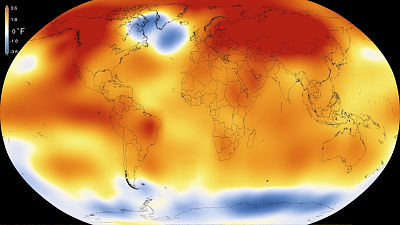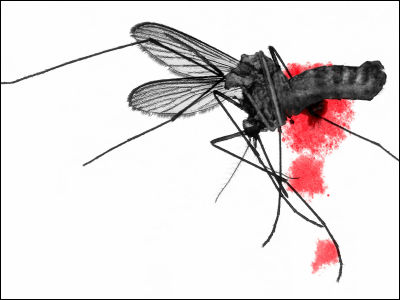なぜ高温多湿だと人が死ぬ危険性が高くなるのか?

近年は地球温暖化に伴って多くの地域で熱中症のリスクが高まっており、2021年6月下旬からカナダやアメリカを襲った熱波では数百人が死亡する事態となっています。熱中症などで死亡するリスクに関係するのは高温だけでなく、湿度の高さも大きく関係しているとのことで、高温多湿の環境が人間の生存を脅かすメカニズムについて、テキサスA&M大学の気象科学者であるアンドリュー・デスラー教授が解説しています。
Quick ???? on wet bulb temperature and why it matters for human survivability.
— Andrew Dessler (@AndrewDessler)
To understand this, first some facts about the human body. To survive, humans need to keep their body temperature within a few degrees of 98°F.
まず、人間の体温は常に摂氏36~37度ほどに保たれており、生きていくにはこの温度より高すぎても低すぎてもいけません。それと同時に、人間の代謝機能は約100W(1秒当たり1ジュール)のエネルギーを生成しているとのことで、生きていくには36~37度の体温を維持しつつ、100Wの熱エネルギーを周囲の環境に放出し続ける必要があります。
At the same time, the human metabolism is generating about 100 watts of power.
— Andrew Dessler (@AndrewDessler)
Put these together and it means that humans need to dump 100 watts into the environment while maintaining this 98°F temperature.
体温を保つ方法には物質の温度変化を伴う「顕熱伝達」と、物質の状態変化を伴う「潜熱伝達」の2つがあります。顕熱伝達では、周囲の空気と体の温度勾配を利用した放熱が行われており、気温が体温より低い場合に体内の熱が空気へと放出されます。なお、気温が摂氏24度~27度だと体から空気に放出される熱エネルギーが100W程度に保たれるため、この範囲の気温は一般的に過ごしやすいとされています。
The perfect air temperature is room temperature (say, 75-80°F). At this temperature, normal air currents in a room will bring cool air into contact with warm skin, transferring 100 watts from the person to the room air.
— Andrew Dessler (@AndrewDessler)
That's why this is the most comfortable temperature.
もし、気温が摂氏24度よりはるかに低い場合、体から放出される熱エネルギーが多くなりすぎるため、人々は服を着込むなどして肌に触れる空気の温度を調節することができます。しかし、気になるのは気温が摂氏27度をはるかに超えた場合です。気温が摂氏30度ほどに上昇すると、通常の気流だけでは体から十分な熱を放出することができなくなります。この問題を解決する方法の1つが、「扇風機などをオンにする」ことです。扇風機などの風で気流が生み出され、皮膚表面の空気の流れが増加すると、温度勾配が低くても100Wの熱エネルギーを放出することができるとデスラー氏は説明しています。
One thing you can do in this case is turn a fan on. This increases flow of air through the room, increasing air flow over the skin. This allows your body to still dump 100 watts of power into the room despite the higher ambient temperature and lower temperature gradient.
— Andrew Dessler (@AndrewDessler)
別の方法には「汗をかく」ことが挙げられます。汗は液体から気体になる(蒸発する)際に、「潜熱伝達」で大量の熱を奪い去ります。1gの汗が蒸発する際に奪われる熱エネルギーは2250ジュールとのことで、毎秒0.04g(毎分2.6g)の汗が蒸発すれば、100Wの熱エネルギーを放出することが可能です。
The other thing your body does is sweat. Sweat works because water, when it evaporates, carries a huge amount of heat away with the vapor: 2250 J/g. To dump 100 watts of power, about 0.04 g/sec of sweat needs to evaporate (2.6 g/min).
— Andrew Dessler (@AndrewDessler)
汗が蒸発する際の潜熱伝達ができれば、気温が36度を超えるほど高くなって顕熱伝達が不可能になっても、体から熱エネルギーを放出できます。そのため、アリゾナ州フェニックスのように乾燥した地域であれば、気温が48度を超えてもなんとか人間が生存できるとのこと。もちろん、48度という気温は人間にとって厳しいものであり、デスラー氏も「私はそれが快適だとは言っていません」と述べています。
This is known as latent heat transfer. It means that, in places that are very dry, like Phoenix, you can survive 120°F because you're sweating like crazy and the sweat can easily evaporate and pull lots of heat out of your body. I didn't say it was comfortable.
— Andrew Dessler (@AndrewDessler)
体が熱エネルギーを放出するには顕熱伝達と潜熱伝達という2つの仕組みがあると把握した上で、「気温が摂氏36.7度で湿度が100%」という状況について考えてみます。気温が摂氏36.7度の場合、体温との温度勾配がないため顕熱伝達は使えず、湿度が100%だと汗が蒸発しないため潜熱伝達も使えません。
Now let's consider a hypothetical: the ambient conditions are 98°F and 100% relative humidity. Because the temperature is 98°F, the same as your body, there is no temperature gradient between your body and the outside, so no sensible heat transfer.
— Andrew Dessler (@AndrewDessler)
そうなると、体が熱エネルギーを放出する手だてがないため、熱エネルギーはそのまま体内にとどまることになり、次第に体温が上昇していきます。
And because the relative humidity is 100%, you can't evaporate any sweat. So there's no latent heat transfer. With no way to dump the 100 watts of heat, the energy accumulates in your body and, via the first law of thermodynamics, your body temperature increases.
— Andrew Dessler (@AndrewDessler)
この状況が続けば、体温が上昇しすぎて死んでしまうとデスラー氏は指摘。そのため、熱波によって死亡する危険性は単なる気温の上昇だけでなく、湿度の上昇も合わせて考慮する必要があります。熱エネルギーの放出ができずに死亡してしまうリスクを検討する上で役に立つのが、「湿球黒球温度」です。
This situation (98°F and 100% RH) will cause your body temperature to increase enough that it will kill you.
— Andrew Dessler (@AndrewDessler)
This is where wet-bulb temperature comes in. It is a combined measure of temperature and humidity and it tells you how dangerous the combination is.
湿球黒球温度は、酷暑環境下での活動リスクを判断するためにアメリカ海兵隊が開発した指標であり、日本の環境省は暑さ指数(WBGT)と称しています。以下の画像が、日本生気象学会が発表した「(PDFファイル)日常生活における熱中症予防指針ver.3」を基にした、相対湿度と気温から簡易に暑さ指数を求めるグラフです。暑さ指数が「31」を超えると「危険」とされており、高温多湿の日本では夏場に「危険」な領域に突入することは珍しくありません。なお、気象庁と環境省は2021年より、暑さ指数を基にした「熱中症警戒アラート」を全国に発表する予定です。

デスラー氏は、「(暑さ指数が)20後半の値になるのはよくありません。値が体温に近い35程度になると生き残るのが難しくなり、それ以上になると死んでしまうでしょう」とコメント。気候変動により、今後は夏場の暑さ指数が30を超える地域が増えるとみられますが、そうした地域は果たして「居住可能」なのかどうかを考える必要があると主張しました。
Values in the upper 20s are bad. Values close to your body temperature (i.e., 35 °C) are not survivable. If you are exposed to those latter conditions, you will die.
— Andrew Dessler (@AndrewDessler)
・関連記事
熱中症による死者の3人に1人は「地球温暖化」が原因で命を落としたとの研究結果 - GIGAZINE
2100年までに猛暑や熱波でどれほどの人が体に深刻な影響を受けるようになるのかを可視化 - GIGAZINE
「今世紀中に数十億人が住む地域で暑さが人体の限界を超える」と気象学者が警告 - GIGAZINE
気温の上昇は人体にどのような影響を与えるのか? - GIGAZINE
観測史上最高の42度を記録したヨーロッパはなぜ猛暑に弱いのか? - GIGAZINE
猛暑に打ち勝つための10の方法 - GIGAZINE
「気温が上昇すると自殺が増える」という研究結果が発表される - GIGAZINE
地球温暖化によって交通事故や暴力事件による死亡者数が増加する可能性がある - GIGAZINE
・関連コンテンツ














